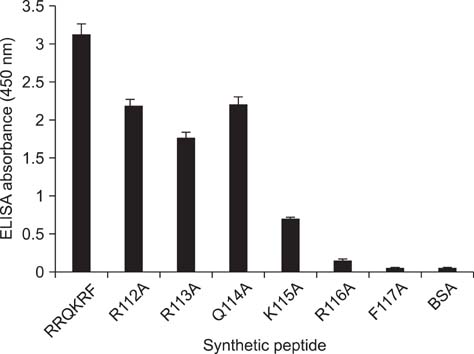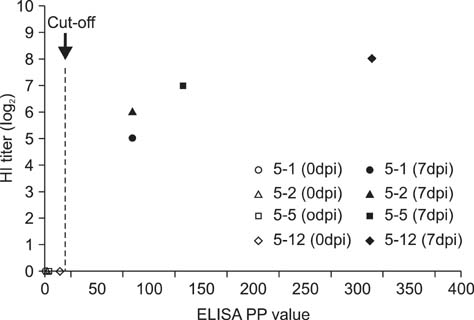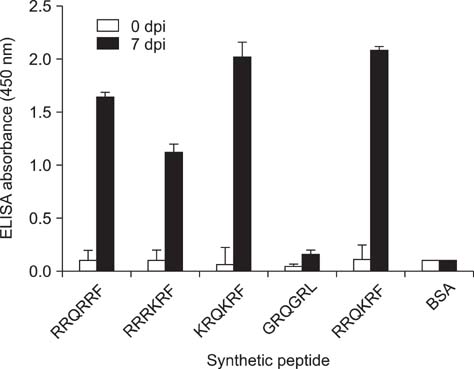J Vet Sci.
2010 Sep;11(3):205-211. 10.4142/jvs.2010.11.3.205.
Antigenic and immunogenic investigation of the virulence motif of the Newcastle disease virus fusion protein
- Affiliations
-
- 1Avian Diseases Division, National Veterinary Research and Quarantine Service, Anyang 430-757, Korea. kchoi0608@korea.kr
- KMID: 1093494
- DOI: http://doi.org/10.4142/jvs.2010.11.3.205
Abstract
- Newcastle disease (ND) caused by virulent Newcastle disease virus (NDV) is a highly contagious viral disease of poultry. Virulent NDVs characteristically have a multibasic amino acid sequence (virulence motif) such as (112)RRQKRF(117) at the cleavage site of the precusor fusion (F0) protein. The antigenic and immunogenic characteristics of the virulence motif (112)RRQKRF(117) in the F0 protein of virulent NDVs were investigated. Epitope mapping analysis revealed that a RRQKRF-specific monoclonal antibody 4G2 recognized the KRF section of the motif. A synthetic peptide bearing the RRQKRF motif reacted strongly with sera from virulent NDV (with RRQKRF motif)-infected chickens. These sera also showed reactivity to peptides bearing other virulence motifs ((112)KRQKRF(117), (112)RRQRRF(117) and (112)RRRKRF(117)) but not an avirulence motif ((112)GRQGRL(117)) by ELISA. The synthetic bearing RRQKRF motif reacted with 60% to 91% of sera taken from surviving chickens on ND outbreak farms but not with sera from vaccinated birds, even though most of the sera had antibody to NDV due to vaccination. This indicates that the virulence motif has the potential to differentiate virulent NDV infected birds from vaccinated birds.
MeSH Terms
-
Amino Acid Motifs/*immunology
Amino Acid Sequence
Animals
Chickens
Enzyme-Linked Immunosorbent Assay/veterinary
Epitope Mapping/veterinary
Newcastle Disease/*immunology
Newcastle disease virus/*genetics/pathogenicity
Poultry Diseases/*immunology/*virology
Serologic Tests/veterinary
Viral Fusion Proteins/*genetics/immunology
Virulence/genetics
Figure
Reference
-
1. Abolnik C, Horner RF, Bisschop SP, Parker ME, Romito M, Viljoen GJ. A phylogenetic study of South African Newcastle disease virus strains isolated between 1990 and 2002 suggests epidemiological origins in the Far East. Arch Virol. 2004. 149:603–619.
Article2. Aldous EW, Mynn JK, Banks J, Alexander DJ. A molecular epidemiological study of avian paramyxovirus type 1 (Newcastle disease virus) isolates by phylogenetic analysis of a partial nucleotide sequence of the fusion protein gene. Avian Pathol. 2003. 32:239–256.
Article3. Alexander DJ. Newcastle Disease. 1988. Boston: Kluwer;147–160.4. Alexander DJ. Saif YM, Barnes HJ, Glisson JR, Fadly AM, McDougald LR, Swayne DE, editors. Newcastle disease, other avian paramyxoviruses, and pneumovirus infections. Diseases of Poultry. 2003. 11th ed. Ames: Iowa State Press;63–99.5. Cantín C, Holguera J, Ferreira L, Villar E, Muñoz-Barroso I. Newcastle disease virus may enter cells by caveolae-mediated endocytosis. J Gen Virol. 2007. 88:559–569.
Article6. Collins MS, Bashiruddin JB, Alexander DJ. Deduced amino acid sequences at the fusion protein cleavage site of Newcastle disease viruses showing variation in antigenicity and pathogenicity. Arch Virol. 1993. 128:363–370.
Article7. de Leeuw O, Peeters B. Complete nucleotide sequence of Newcastle disease virus: evidence for the existence of a new genus within the subfamily Paramyxovirinae. J Gen Virol. 1999. 80:131–136.
Article8. Eckert DM, Kim PS. Mechanisms of viral membrane fusion and its inhibition. Annu Rev Biochem. 2001. 70:777–810.
Article9. Flint SJ, Enquist LW, Krug RM, Racaniello VR, Skalka AM. Principles of Virology: Molecular Biology, Pathogenesis, and Control. 2000. Washington DC: ASM Press;132–161.10. Gorman JJ, Corino GL, Selleck PW. Comparison of the positions and efficiency of cleavage activation of fusion protein precursors of virulent and avirulent strains of Newcastle disease virus: insights into the specificities of activating proteases. Virology. 1990. 177:339–351.
Article11. Gorman JJ, Nestorowicz A, Mitchell SJ, Corino GL, Selleck PW. Characterization of the sites of proteolytic activation of Newcastle disease virus membrane glycoprotein precursors. J Biol Chem. 1988. 263:12522–12531.
Article12. Hodder AN, Selleck PW, White JR, Gorman JJ. Analysis of pathotype-specific structural features and cleavage activation of Newcastle disease virus membrane glycoproteins using antipeptide antibodies. J Gen Virol. 1993. 74:1081–1091.
Article13. Kawahara N, Yang XZ, Sakaguchi T, Kiyotani K, Nagai Y, Yoshida T. Distribution and substrate specificity of intracellular proteolytic processing enzyme(s) for paramyxovirus fusion glycoproteins. J Gen Virol. 1992. 73:583–590.
Article14. Krishnamurthy S, Samal SK. Nucleotide sequences of the trailer, nucleocapsid protein gene and intergenic regions of Newcastle disease virus strain Beaudette C and completion of the entire genome sequence. J Gen Virol. 1998. 79:2419–2424.
Article15. Lee YJ, Sung HW, Choi JG, Kim JH, Song CS. Molecular epidemiology of Newcastle disease viruses isolated in South Korea using sequencing of the fusion protein cleavage site region and phylogenetic relationships. Avian Pathol. 2004. 33:482–491.
Article16. Li Y, Collins MS, Whitelam GC, Alexander DJ. Rapid pathotyping of Newcastle disease virus using a single-chain Fv displayed on phage against the C-terminal end of the F2 polypeptide. Arch Virol. 2002. 147:2025–2037.
Article17. Liu H, Wang Z, Wu Y, Zheng D, Sun C, Bi D, Zuo Y, Xu T. Molecular epidemiological analysis of Newcastle disease virus isolated in China in 2005. J Virol Methods. 2007. 140:206–211.
Article18. Lomniczi B, Wehmann E, Herczeg J, Ballagi-Pordány A, Kaleta EF, Werner O, Meulemans G, Jorgensen PH, Mantè AP, Gielkens AL, Capua I, Damoser J. Newcastle disease outbreaks in recent years in Western Europe were caused by an old (VI) and a novel genotype (VII). Arch Virol. 1998. 143:49–64.
Article19. Lopaticki S, Morrow CJ, Gorman JJ. Characterization of pathotype-specific epitopes of newcastle disease virus fusion glycoproteins by matrix-assisted laser desorption/ionization time-of-flight mass spectrometry and post-source decay sequencing. J Mass Spectrom. 1998. 33:950–960.
Article20. Morrison TG. Structure and function of a paramyxovirus fusion protein. Biochim Biophys Acta. 2003. 1614:73–84.
Article21. Pedersen JC, Senne DA, Woolcock PR, Kinde H, King DJ, Wise MG, Panigrahy B, Seal BS. Phylogenetic relationships among virulent Newcastle disease virus isolates from the 2002-2003 outbreak in California and other recent outbreaks in North America. J Clin Microbiol. 2004. 42:2329–2334.
Article22. Peeters BP, de Leeuw OS, Koch G, Gielkens AL. Rescue of Newcastle disease virus from cloned cDNA: evidence that cleavability of the fusion protein is a major determinant for virulence. J Virol. 1999. 73:5001–5009.
Article23. Sakaguchi T, Matsuda Y, Kiyokage R, Kawahara N, Kiyotani K, Katunuma N, Nagai Y, Yoshida T. Identification of endoprotease activity in the trans Golgi membranes of rat liver cells that specifically processes in vitro the fusion glycoprotein precursor of virulent Newcastle disease virus. Virology. 1991. 184:504–512.
Article24. San Román K, Villar E, Muñoz-Barroso I. Acidic pH enhancement of the fusion of Newcastle disease virus with cultured cells. Virology. 1999. 260:329–341.
Article25. Scanlon DB, Corino GL, Shiell BJ, Della-Porta AJ, Manvell RJ, Alexander DJ, Hodder AN, Gorman JJ. Pathotyping isolates of Newcastle disease virus using antipeptide antibodies to pathotype-specific regions of their fusion and hemagglutinin-neuraminidase proteins. Arch Virol. 1999. 144:55–72.
Article26. van Regenmortel MHV, Fauquet CM, Bishop DHL, Carsten EB, Estes MK, Lemon SM, Maniloff J, Mayo MA, McGeoch DJ, Pringle CR, Wickner RB. Virus Taxonomy: Seventh Report of the International Committee on Taxonomy of Viruses. 2000. San Diego: Academic Press;1024.
- Full Text Links
- Actions
-
Cited
- CITED
-
- Close
- Share
- Similar articles
-
- Expression of F Protein Gene of a Thermostable Isolate of Newcastle Disease Virus Using Baculovirus Expression System
- Characterisation of genotype VII Newcastle disease virus (NDV) isolated from NDV vaccinated chickens, and the efficacy of LaSota and recombinant genotype VII vaccines against challenge with velogenic NDV
- Improved immunogenicity of Newcastle disease virus inactivated vaccine following DNA vaccination using Newcastle disease virus hemagglutinin-neuraminidase and fusion protein genes
- Generation and Biological Characterization of a Neutralization-Resistant Mutant of Newcastle Disease Virus
- N-Linked Glycosylation in the Hemagglutinin of Influenza A Viruses




